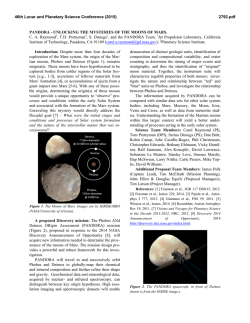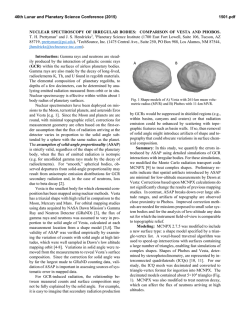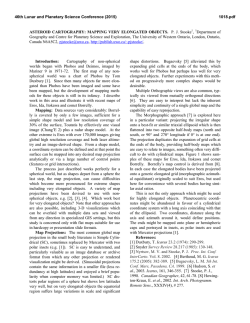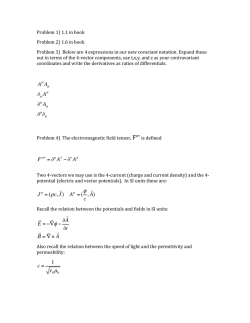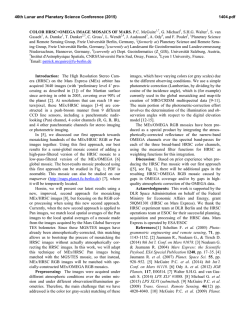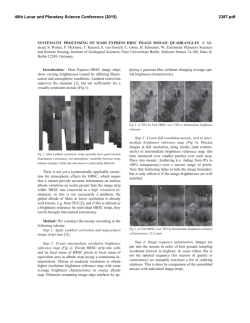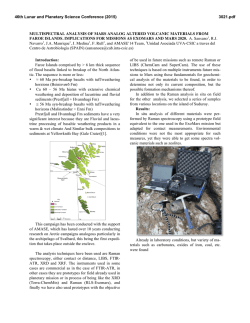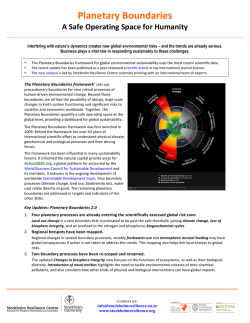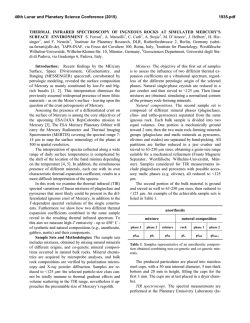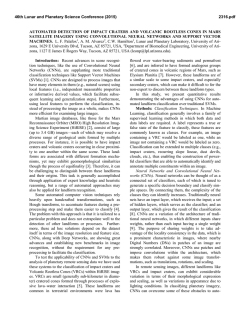
UPDATED SHAPE MODELS OF PHOBOS AND DEIMOS FROM
46th Lunar and Planetary Science Conference (2015) 2753.pdf UPDATED SHAPE MODELS OF PHOBOS AND DEIMOS FROM STEREOPHOTOCLINOMETRY. Carolyn M. Ernst1, Robert W. Gaskell2, Eliezer G. Kahn1, Olivier S. Barnouin1, James H. Roberts1, and Kielan K. Wilcomb3. 1Johns Hopkins University Applied Physics Laboratory, Laurel, MD 20723, USA ([email protected]); 2Planetary Science Institute, Tucson, AZ 85719, USA; 3Towson University, Towson, MD 21252. Introduction: The flotilla of Mars-bound spacecraft sent by NASA, ESA, and the USSR over the past ~40 years has provided many opportunities for diskresolved observations of Phobos and Deimos, placing the martian moons among the best-observed small bodies in the solar system. Despite this status, the origin, evolution, composition, and structure of the moons are not well understood. This lack of understanding is in part due to major challenges inherent in analyzing the available datasets. The data assortment obtained during a number of brief encounters are difficult to synthesize and compare, due to complexities of coordinating spacecraft positioning, instrument pointing, data calibration, and data archives. Yet this synthesis is critical for comprehensive and up-to-date analyses of Phobos and Deimos. The irregular shape of the bodies also poses a considerable obstacle. Visualizing and mapping features on such bodies becomes a difficult task, and two-dimensional map projections lead to severe distortions of spatial relationships and size. We circumvent these obstacles by building updated shape models of Phobos and Deimos. The Small Body Mapping Tool (SBMT) [2] is used to visualize the Figure 1. Comparison of the new Phobos shape model (left) and the PDS-archived Gaskell shape model [1] (right). Green arrows point out some of the areas where improvements are readily seen, including definition of previously unresolved craters and grooves. 46th Lunar and Planetary Science Conference (2015) models and to map structures and images directly onto the models in three dimensions. Shape Modeling: Existing shape models of Phobos and Deimos were constructed primarily using Viking Orbiter images. A high-resolution Phobos shape model was created using stereophotoclinometry (SPC) [1]. A low-resolution shape model of Deimos was created using a combination of limb and stereogrammetric data [3]. We used SPC [4] to create updated and detailed shape and topography models of Phobos and Deimos, adding Viking Orbiter data to the more recent image data acquired by the Mars Global Surveyor Mars Orbiter Camera (MOC), the Mars Express High Resolution Stereo Camera (HRSC), and the Mars Reconnaissance Orbiter High Resolution Imaging Science Experiment (HiRISE) that are available in the Planetary Data System. None of these spacecraft performed close flybys of Deimos—the newer images helped to better constrain the overall shape, using SPC for the first time to model Deimos. The additional Phobos coverage, however, leads to marked improvements in the shape model, especially due to the global coverage from HRSC (Figure 1). We calculated elevation, slope, gravitational potential, and gravitational acceleration maps of both moons 2753.pdf using the updated shape and topography models, knowledge of the moons’ rotations, and assuming a uniform density [5]. Elevation is defined relative to a reference gravitational potential equivalent to a ‘geoid’, calculated from the area averaged root mean square of the gravitational potential. Slope is defined relative to gravitational acceleration. Figure 2 shows slope maps of Phobos and Deimos. Small Body Mapping Tool: We have developed the capability to search and display all of the Phobos and Deimos image data from Mariner 9, Viking Orbiter, Phobos 2, MOC, HRSC, and HiRISE directly on the shape models. This allows the user to find available images of an area of interest, to view and manipulate the images projected onto the moons’ surfaces, and to map features (e.g., craters, grooves, blocks) directly onto the shapes using the images. These SBMT capabilities will join those for Eros and Itokawa (sbmt.jhuapl.edu) in being made publically available at the end of the project. References: [1] Gaskell, R.W. (2013) NASA Planetary Data System, 155. [2] Kahn, E.G. et al. (2011) LPS 42, 1618. [3] Thomas, P.C. (1993) Icarus, 105, 326–344. [4] Gaskell, R.W. et al. (2008) Meteorit. Planet. Sci. 43, 1049–1061. [5] Cheng, A.F. et al. (2012) Asteroids Comets and Meteors, abstract 6447. Figure 2. Slope maps of Phobos (high-resolution) and Deimos (low-resolution), computed from the shape models using the methods of [5].
© Copyright 2025
